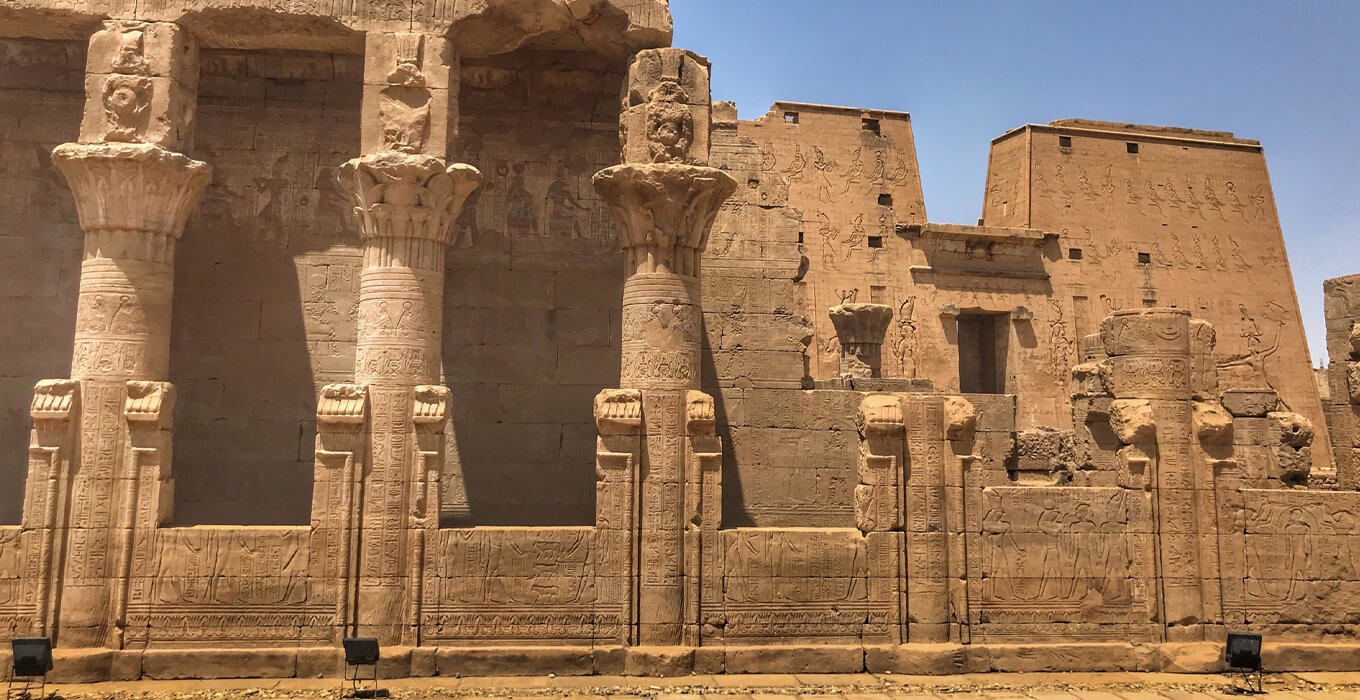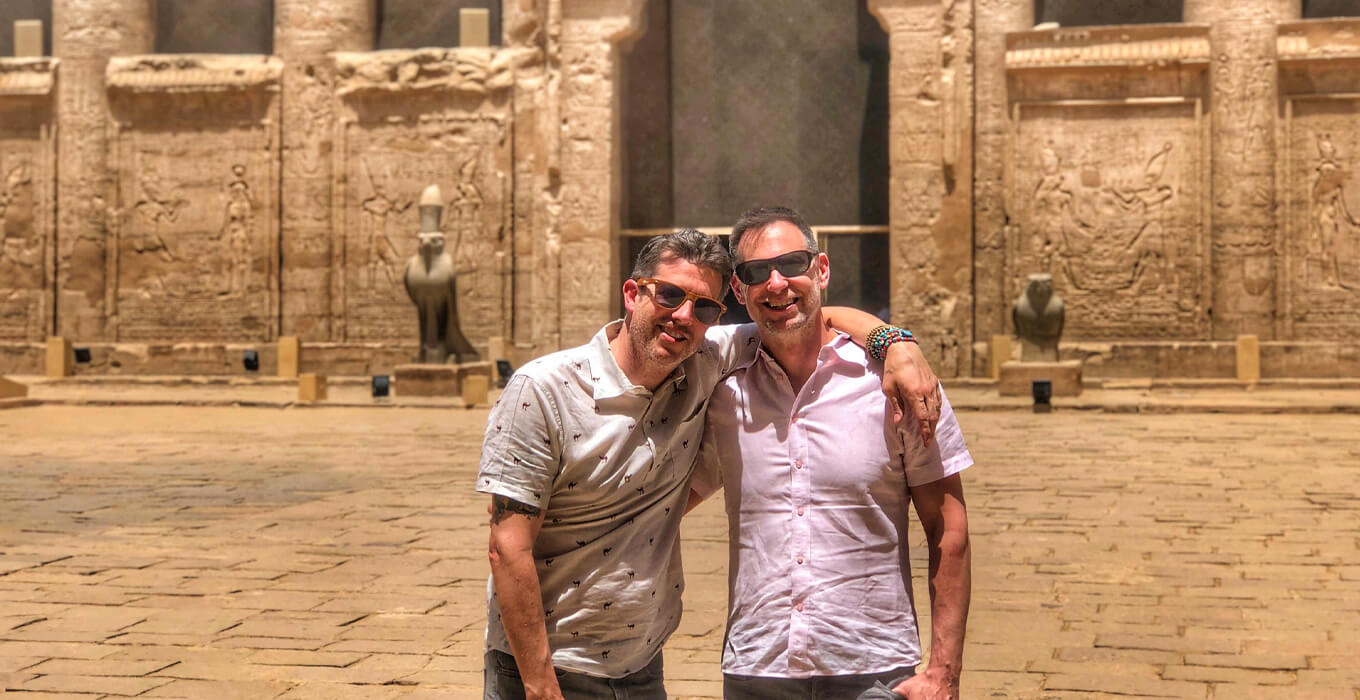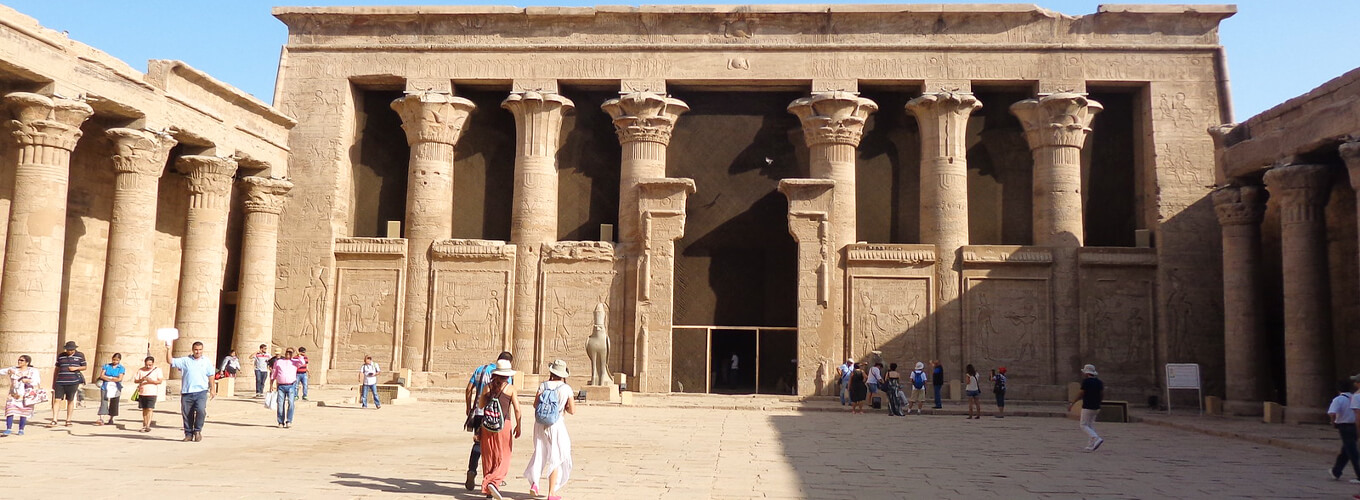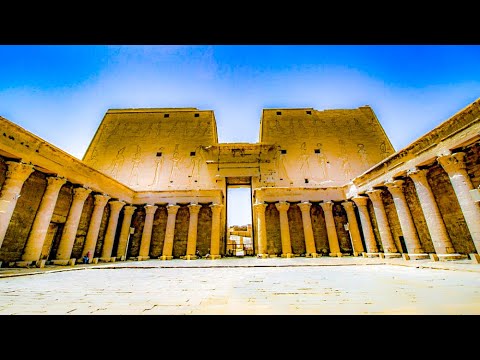The Temple of Edfu sits by the Nile River in Upper Egypt. It shows the lasting impact of ancient Egyptian culture. Built over 180 years, from 237 BC to 57 BC, it honors the god Horus.
This huge temple covers 7,000 square meters. It has a 36-meter-high entrance, a big forecourt with 32 columns, and halls full of art. Its history, myths, and preserved writings draw in experts and tourists.
Key Takeaways
- The Temple of Edfu is a huge ancient Egyptian temple by the Nile River in Upper Egypt.
- It took 180 years to build, from 237 BC to 57 BC, during the Ptolemaic Kingdom.
- The temple is big, with a 36-meter-high entrance, a big forecourt, and halls full of art.
- It’s for the falcon god Horus and is famous for its well-preserved writings and myths.
- The Temple of Edfu is a key spot for archaeologists and tourists, showing ancient Egyptian greatness.
Introduction to the Temple of Edfu
The Temple of Edfu is a key ancient Egyptian site. It shows us the architecture and religious life of the Ptolemaic period. Built over 180 years, it honors Horus and Hathor. It’s one of the last ancient Egyptian temples made.
Overview of the Temple’s Historical Significance
The Temple of Edfu is very important in history. It was the first big temple built by the Ptolemaic dynasty in Egypt. It shows the long-lasting support for the Horus cult over many generations.
It’s by the Nile River, in a key spot for ancient Egyptian culture. This made it very important then.

Location and Geographical Context
The Temple of Edfu is on the Nile’s west bank, in Edfu, Upper Egypt. The town’s name comes from the ancient Egyptian Djeba or Etbo in Coptic. Being in the Nile valley made it a center of ancient Egyptian life.
| Key Facts | Details |
| Location | Edfu, Upper Egypt, on the west bank of the Nile River |
| Dedication | Falcon god Horus and his consort Hathor of Dendera |
| Construction Period | 237 BC to 57 BC, during the Ptolemaic dynasty |
| Architectural Style | Fusion of ancient Egyptian and ancient Greek styles |
| Rediscovery | Discovered in 1860 AD by French Egyptologist Auguste Mariette |
History and Construction
The Temple of Edfu is by the Nile River in Upper Egypt. It shows the lasting impact of the Ptolemaic dynasty. Built over 180 years, from 237 BC to 57 BC, it was done by several Ptolemaic pharaohs.
Ptolemaic Kingdom and Pharaohs Involved
Ptolemy III Euergetes I started building the Temple of Edfu in 237 BC. Ptolemy VIII Euergetes II took over in 142 BC. Ptolemy XII Auletes finished it in 57 BC.
Even with Greco-Roman influence, the temple kept its ancient Egyptian look.
Construction Timeline and Phases
The building took nearly two centuries to finish. It went through many phases. Ptolemy III Euergetes I started it in 237 BC.
Ptolemy VIII Euergetes II worked on it next in 142 BC. Ptolemy XII Auletes finished the main parts in 70 BC.
The last part, adding the main entrance doors, was done in 57 BC.
| Pharaoh | Year | Contribution |
| Ptolemy III Euergetes I | 237 BC | Initiated the construction of the Temple of Edfu |
| Ptolemy VIII Euergetes II | 142 BC | Continued the construction of the temple |
| Ptolemy XII Auletes | 57 BC | Finalized the construction, including the main entrance wooden doors |
Architectural Marvels
The Temple of Edfu is famous for its Temple of Edfu architecture. It has a monumental pylon and entrance gateway. The entrance has a huge gate with towers that are about 36 meters tall. The pylon facade has four depressions for 40-meter-high wooden flagpoles.
Inside the pylon towers, there are four stories with chambers and storerooms. You can get to these via staircases that also go to the roof.
Forecourt and Outer Hypostyle Hall
The monumental gateway leads to a big forecourt. It’s surrounded by 32 columns on three sides. This was where big festivals and rituals happened, like the Feast of the Joyous Union.
After the forecourt, there’s the outer hypostyle hall. This is a columned hall that kept the inner sanctum of the temple private, except during festivals.
| Architectural Feature | Dimension/Details |
| Monumental Pylon | Two towers measuring approximately 36 meters in height |
| Facade of Pylon | Four depressions that once held 40-meter-high wooden flagpoles |
| Forecourt | Large paved area surrounded on three sides by 32 columns |
| Outer Hypostyle Hall | Columned hall that restricted public access to the temple’s inner sanctum |
The Temple of Edfu shows off Ptolemaic architecture of ancient Egypt. It’s a testament to the skill of its builders. The temple’s columned halls and big entrance gateway still amaze visitors and experts. They give us a peek into the architectural wonders of the Ptolemaic period.
Horus Cult and Sacred Rituals
The Temple of Edfu was a key spot for the Horus cult. Horus, the falcon god, was the main god worshipped there. The temple also honored Hathor of Dendera, Horus’s partner. A big festival, the Festival of the Living Falcon, was held there every year.
A living sacred falcon was picked by Horus’s statue as its new heir during this festival. This was done through an oracle. The coronation of the falcon happened on the temple’s big gateway. The falcon and Horus’s statue came together for this special event.
This ritual showed the deep bond between the ancient Egyptians and their gods. They saw the sacred creatures as the gods’ earthly forms.
| Festival | Celebration | Timing |
| New Year Ceremony | Marking the first rising of the Nile | First Day of the Inundation Season (July 19) |
| Festival of Joyous Union | Celebrating the marriage of Hathor to Horus | August, lasting 15 days |
| Coronation of the Sacred Falcon | Annual ceremony for the sacred falcon chosen as Horus’s heir | First 5 days of the First Month of Winter (November) |
| Festival of Victory | Sacred drama based on the myth of Horus taking revenge on Seth | 21st day of the Second Month of Winter (December) |
These rituals and festivals at the Temple of Edfu were key to ancient Egyptian religion. They showed the deep bond between Horus, Hathor, and the living falcon. This was a big part of the Horus cult’s belief in the natural world and its mystical links.
Hieroglyphic Inscriptions and Wall Carvings
The Temple of Edfu’s walls show us ancient Egyptian myths and religious ways. They tell us about the Horus cult and what people believed. These carvings and writings are like windows into the past.
Creation Myth and Sacred Drama
The temple’s walls share the creation myth of Edfu. It talks about the fight between land and water, the rise of reeds, and Horus, the god with a falcon head. It also tells of the “Sacred Drama,” a ritual of Horus vs. Seth, seeking revenge for Osiris’s death.
Religious Iconography and Symbolic Imagery
The temple’s walls are full of symbols and images from the Horus cult. You’ll see Horus and his partner, the goddess Hathor. Other gods like Nekhbet and Wadjet are there too, showing the temple’s importance in worship.
These inscriptions and carvings are not just pretty. They’re key to understanding ancient Egyptian beliefs and culture. They let us peek into the life of the Temple of Edfu.
Temple of Edfu in Egypt’s Archaeological Significance
The Temple of Edfu is a key part of ancient Egyptian history. It’s one of the most well-preserved temples in Egypt. This temple lets us see what life was like during the Ptolemaic period.
It took 180 years to build, starting in 237 BCE. The temple honors the god Horus, a big part of Egyptian stories. It’s full of information about ancient Egyptian myths, language, and building skills.
French archaeologist Auguste Mariette found the temple in the 1860s. It was buried under sand for centuries. Now, it shows us the lasting impact of ancient Egyptian culture.

| Key Facts about the Temple of Edfu | Details |
| Construction Timeline | Constructed over 180 years, starting in 237 BCE |
| Rediscovery | Rediscovered in the 1860s by French archaeologist Auguste Mariette |
| Deity Worshipped | Falcon god Horus, associated with the sky, healing, kingship, and protection |
| Architectural Highlights | Monumental pylon, forecourt, and hypostyle halls |
Influence on Architecture and Design
The Temple of Edfu’s grand and well-preserved architectural influence has greatly affected later designs. This is especially true in the British architecture tradition. The temple’s design inspired the Temple Works in Holbeck, Leeds, England. The courtyard columns there were made to look like those in Edfu.
This shows the lasting Greco-Roman influence of ancient Egyptian temples on European design. The Temple of Edfu’s unique look and details have amazed architects and designers around the world. It has become a key example of architectural influence that goes beyond time and place.
British Architecture Inspiration
The Temple Works in Holbeck, Leeds, England, built in the 19th century, is a great example of Edfu’s impact on British architecture. Its big entrance and columned area show a mix of Greco-Roman influence and local style.
| Architectural Feature | Temple of Edfu | Temple Works, Holbeck |
| Pylon Entrance | Monumental and imposing | Echoes the grand scale and proportions |
| Columned Forecourt | Iconic and symmetrical | Closely modeled after Edfu’s design |
| Overall Aesthetic | Distinctly ancient Egyptian | Blends Egyptian and European elements |
This shows how the ancient Egyptian temple and a British building talk to each other. It highlights the lasting influence of the Temple of Edfu. It has shaped design traditions across continents and through time.
Visiting the Temple Today
The Temple of Edfu is a top spot for cultural tourism in Egypt. It draws visitors from all over the world. They come to see its ancient architecture and history. The site has gotten better for visitors, with a new visitor center and paved parking.
Now, the temple is easy for everyone to get to. It keeps the site’s history safe while letting visitors see its beauty.
Tourism Facilities and Accessibility
The Temple of Edfu has many facilities for tourists. There’s a visitor center with info on the temple’s history. And, there’s a paved parking area for all the visitors.
The temple is easy to get around, thanks to paths and ramps. This means everyone can see the ancient structure.
Night Visits and Lighting System
The Temple of Edfu now has a special lighting for night visits. This was added in late 2006. It lets tourists see the temple’s beauty at night.
Now, night visits are a big draw. They let visitors see the temple in a new and magical way.
| Feature | Temple of Edfu | Luxor Temple |
| Entrance Fee | 100 Egyptian pounds (approx. €5.70) | 100 Egyptian pounds (approx. €5) |
| Construction Timeline | Ptolemaic Dynasty, 2nd century BC | One of the largest and best-preserved temples in Egypt |
| Visitor Duration | Approximately 2 hours and 30 minutes | N/A |
| Accessibility Features | Pathways and ramps for mobility-challenged visitors | N/A |
| Lighting System | Specialized lighting for night visits, installed in 2006 | N/A |
The Temple of Edfu is getting more popular for cultural tourism in Egypt. Its facilities, easy access, and night lighting make it special. Visitors can enjoy the temple’s history and beauty any time of day.
Preservation Efforts and Conservation
The Temple of Edfu in Egypt has been protected and kept safe for many years. It was found again in the 19th century by French Egyptologist Auguste Mariette. He started to clear the site of sand and debris.
Now, there are ongoing efforts to keep the temple strong and safe. These efforts tackle threats like weather damage and erosion. They also work to make tourism sustainable, so it doesn’t harm the site.
The Tell Edfu Project began in 2001 and is still going strong. It’s very important for the temple and its history. Excavations started in 2005 and have found many things. They’ve given us a lot of new information about the site.
- Over the past two decades, the Tell Edfu Project has made big strides in understanding the ancient site and its cultural heritage.
- Since 2017, a new excavation area has been started on an early New Kingdom domestic quarter at Edfu, further enhancing our knowledge of the site’s history.
- The project involves a multidisciplinary team of specialists, including archaeologists, conservators, Egyptologists, ceramic experts, and archaeozoologists, working to unravel the complex layers of Edfu’s past.
Preserving the Temple of Edfu is part of a big effort to protect Egypt’s cultural treasures. Other temples like the Temple of Hathor in Dendera and the Temple of Horus in Kom Ombo have also been restored and cared for.
These efforts help keep the Temple of Edfu and other ancient sites safe. They make sure these places can be enjoyed by people from all over the world.
The Temple of Edfu in Egypt’s Cultural Legacy
The Temple of Edfu is a key part of ancient Egyptian civilization’s lasting cultural legacy. It was a key spot for the Horus cult and shows off Ptolemaic-era architecture. The temple is very well kept and has lots of writings and pictures that tell us a lot about the old Egyptians.
It’s a big deal in Egypt, showing off the country’s deep history. People who love history or just want to see amazing places should go there. The temple has huge walls and detailed carvings that show the old Egyptians’ spiritual and artistic side.
Building the temple started in 237 BC under Pharaoh Ptolemy III and finished in 57 BC with Ptolemy XII. This shows how much the Ptolemaic dynasty cared about ancient Egyptian traditions. The temple is a big deal because it shows how smart and cultured the Ptolemaic period was.
Now, the Temple of Edfu draws visitors from all over the world. It’s like a living museum that keeps the spirit of ancient Egyptian life alive. Its lasting impact and importance make it a key part of Egypt’s history and culture. It leaves everyone who sees it in awe.
Conclusion
The Temple of Edfu is a key part of ancient Egyptian history. It honors the falcon god Horus and shows the rich culture of the Nile River valley. The Temple of Edfu is a must-see for anyone interested in Egypt’s ancient Egyptian temple history.
This Horus cult temple from the Ptolemaic period is very well kept. Thanks to efforts to preserve it, it will keep inspiring people for many years. It lets us see the beauty of Egypt’s cultural significance and tourism.
Visitors can see huge pylons, detailed hieroglyphics, and learn about the Horus cult. The Temple of Edfu is a place that leaves a lasting impression. It shows the creativity and faith of the Nile River civilization. The Temple of Edfu will continue to amaze people from all over the world for many years.
Read our related articles:


